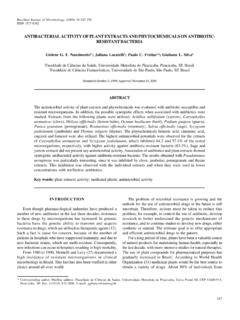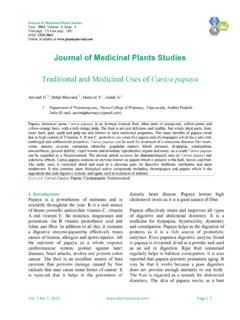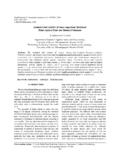Transcription of Antimicrobial properties of allicin from garlic
1 Microbes and Infection, 2, 1999, 125 129. Elsevier, Paris Review Antimicrobial properties of allicin from garlic Serge Ankri*, David Mirelman Department of Biological Chemistry, Weizmann Institute of Science, Rehovot 76100, Israel ABSTRACT allicin , one of the active principles of freshly crushed garlic homogenates, has a variety of Antimicrobial activities. allicin in its pure form was found to exhibit i) antibacterial activity against a wide range of Gram-negative and Gram-positive bacteria, including multidrug-resistant enterotoxicogenic strains of Escherichia coli; ii) antifungal activity , particularly against Candida albicans.
2 Iii) antiparasitic activity , including some major human intestinal protozoan parasites such as Entamoeba histolytica and Giardia lamblia; and iv) antiviral activity . The main Antimicrobial effect of allicin is due to its chemical reaction with thiol groups of various enzymes, alcohol dehydrogenase, thioredoxin reductase, and RNA polymerase, which can affect essential metabolism of cysteine proteinase activity involved in the virulence of E. histolytica. Elsevier, Paris alliinase / allicin / thiol enzymes / antibiotics / garlic / antimicrobials 1. Introduction garlic is one of the edible plants which has generated a lot of interest throughout human history as a medicinal panacea.
3 A wide range of microorganisms including bac- teria, fungi, protozoa and viruses have been shown to be sensitive to crushed garlic preparations. Moreover, garlic has been reported to reduce blood lipids and to have anticancer effects. Chemical analyses of garlic cloves have Figure 1. Generation of allicin in a garlic clove. revealed an unusual concentration of sulfur-containing compounds (1 3%) [1, 2]. Analysis of steam distillations of crushed garlic cloves performed over a century ago showed a variety of allyl amino acid that is present in large quantities in garlic sulfides.
4 However, it was not until 1944 that Cavallito and cloves and which they named alliin (figure 1). Alliin was his colleagues [3] isolated and identified the component found to be the stable precursor that is converted to allicin responsible for the remarkable antibacterial activity of by the action of an enzyme termed alliinase which is also crushed garlic cloves. The compound turned out to be an present in the cloves [6]. Only one isomer of alliin ((+)-S- oxygenated sulfur compound which they termed allicin , allyl-L-cysteine-sulfoxide) was found to be present, which from the Latin name of the garlic plant, Allium sativum.
5 In itself had no Antimicrobial activity . The amounts of alliin Pure allicin is a volatile molecule that is poorly miscible in and allicin present in different strains of garlic were stud- aqueous solutions and which has the typical odor of ied by numerous investigators. Considerable variations freshly crushed garlic [4]. Final proof of the chemical have been reported, ranging from to mg/gram structure of allicin (figure 1) came in 1947, when it was found in Romanian red [2]. shown that allicin could be synthesized by mild oxidation The transformation of alliin into the biologically active of diallyl disulfide [2].
6 The debate on the presence of allicin molecule upon crushing of a garlic clove is ex- allicin in crushed cloves versus its absence in odorless tremely rapid, being complete in seconds. The enzyme intact cloves was resolved after Stoll and Seebeck [5] responsible for the lysis is alliinase, or alliin-lyase isolated, identified, and synthesized an oxygenated sulfur ( ), a pyridoxal 5-phosphate-dependent glyco- protein consisting of two subunits [7, 8]. Alliinase is present in unusually high amounts in garlic cloves: at least * Correspondence and reprints 10% of the total protein content (10 mg/g fresh weight).
7 Microbes and Infection 125. 1999, 125-129. Review Ankri and Mirelman The gene coding for the enzyme has been cloned, and 2. antibacterial activity of allicin upon translation, found to consist of 448 amino acids with a protein molecular mass of kDa and together with The antibacterial properties of crushed garlic have been a carbohydrate content of 6%, gives 55 000 kDa [7, known for a long time. Various garlic preparations have 8]. Alliinase has 10 cysteine residues, all of them in S-S been shown to exhibit a wide spectrum of antibacterial bridges, and their reduction, or the removal of the pyri- activity against Gram-negative and Gram-positive bacte- doxal coenzyme factor, renders the enzyme inactive.
8 Ex- ria including species of Escherichia, Salmonella, Staphy- pression of a recombinant alliinase has been achieved in lococcus, Streptococcus, Klebsiella, Proteus, Bacillus, and the baculovirus system, and although protein yields were Clostridium. Even acid-fast bacteria such as Mycobacte- impressive, the enzymatic activity was very poor due to rium tuberculosis are sensitive to garlic [10]. garlic ex- difficulties with folding of the protein (Mirelman et al., tracts are also effective against Helicobacter pylori, the unpublished results). Moreover, in the clove, alliinase is cause of gastric ulcers [11].
9 garlic extracts can also pre- found closely associated with a lectin [9]. The site of vent the formation of Staphylococcus enterotoxins A, B, linkage of the carbohydrate moieties of alliinase has been and C1 and also thermonuclease [12]. On the other hand, identified at Asp 146 [9]. Significant homology has been it seems that garlic is not effective against toxin formation reported between the garlic and onion alliinases, although of Clostridium botulinum [13]. Cavallito and Bailey [4]. alliin was not detected in the latter species. were the first to demonstrate that the antibacterial action garlic cloves are odor-free until crushed.
10 Cross-section of garlic is mainly due to allicin [3]. The sensitivity of studies have indicated that the substrate alliin and the various bacterial and clinical isolates to pure preparations enzyme alliinase are located in different compartments [2, of allicin [14] is very significant. As shown in table I. 6]. This unique organization suggests that it is designed as (Mirelman et al., unpublished results) the antibacterial a potential defense mechanism against microbial patho- effect of allicin is of a broad spectrum. In most cases the gens of the soil.







